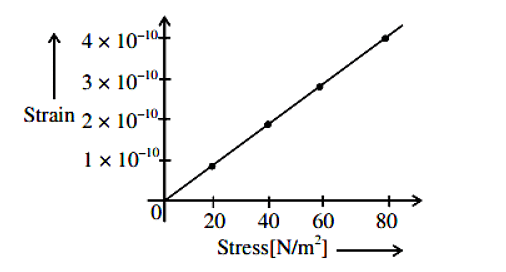When a body is strained, energy stored per unit volume is (Y-Young's modulus)
- $\frac{(stress)}{Y}$
- $\frac{ Y\times (strain)}{2}$
$\frac1{2} \frac{(stress)}{Y}$
- $ Y\times (strain)^2$
$\frac{(stress)^2}{2Y}$
The Correct Option is
Solution and Explanation
When a body is strained, the energy stored per unit volume (also known as the strain energy density) is related to the stress and strain through Young's modulus \( Y \).
The formula for the energy stored per unit volume is derived from the relationship between stress and strain, and it is given by: \[ \text{Energy per unit volume} = \frac{1}{2} \times \text{stress} \times \text{strain} \] Since stress (\( \sigma \)) is related to Young's modulus (\( Y \)) and strain (\( \epsilon \)) by: \[ \sigma = Y \times \epsilon \] Therefore, strain (\( \epsilon \)) can be written as: \[ \epsilon = \frac{\sigma}{Y} \] Substituting this into the energy formula: \[ \text{Energy per unit volume} = \frac{1}{2} \times \sigma \times \frac{\sigma}{Y} = \frac{1}{2} \times \frac{\sigma^2}{Y} \] Thus, the energy stored per unit volume is: \[ \text{Energy per unit volume} = \frac{1}{2} \times \frac{\text{stress}^2}{Y} \]
Correct Answer:
Correct Answer: (E) \( \frac{(stress)^2}{2Y} \)
Top Questions on elastic moduli
- The law which states that within elastic limits strain produced is proportional to the stress producing it is known as
- JKCET - 2024
- Physics
- elastic moduli
- The slope of the stress-strain curve in the elastic deformation region is
- JKCET - 2024
- Physics
- elastic moduli
- A wire of length L and radius r is clamped rigidly at one end. When the other end of the wire is pulled by a force F, its length increases by 5 cm. Another wire of the same material of length 4L and radius 4r is pulled by a force 4F under same conditions. The increase in length of this wire is ___ cm.
- JEE Main - 2022
- Physics
- elastic moduli
The elastic behavior of material for linear stress and linear strain, is shown in the figure. The energy density for a linear strain of 5×10–4 is ____ kJ/m3. Assume that material is elastic up to the linear strain of 5×10–4

- JEE Main - 2022
- Physics
- elastic moduli
- If the length of a wire is made double and radius is halved of its respective values. Then, the Young’s modulus of the material of the wire will :
- JEE Main - 2022
- Physics
- elastic moduli
Questions Asked in KEAM exam
- A lift having mass 1000kg moves upward against a frictional force of 2000N. Power given by motor is 36000W. What is the velocity of the lift?
- KEAM - 2025
- Speed, Time and Distance
- Solve for \( a \) and \( b \) given the equations: \[ \sin x + \sin y = a, \quad \cos x + \cos y = b, \quad x + y = \frac{2\pi}{3} \]
- KEAM - 2025
- Trigonometry
- If \( A \) is a \( 3 \times 3 \) matrix and \( |B| = 3|A| \) and \( |A| = 5 \), then find \( \left| \frac{\text{adj} B}{|A|} \right| \).
- KEAM - 2025
- Matrix Operations
- An unbiased die is tossed until a sum \( S \) is obtained. If \( X \) denotes the number of times tossed, find the ratio \( \frac{P(X = 2)}{P(X = 5)} \).
- KEAM - 2025
- Probability
- If $ f(x) = \log 3 - \sin x $, $ y = f(f(x)) $, find $ y(0) $.
- KEAM - 2025
- Functions